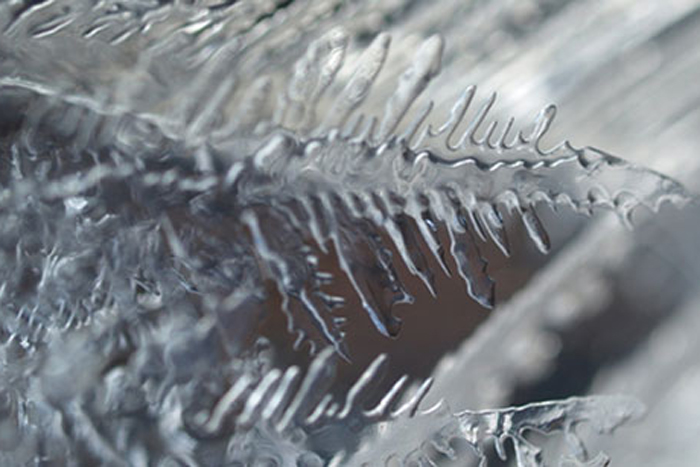
Bacteria found everywhere from the lower atmosphere to the Amazon rainforest may help form ice by manipulating the forces between water molecules, new research suggests.
The bacteria, Pseudomonas syringae, use special proteins to alternatingly repel and attract water molecules, squishing the H20 molecules into high- and low-density patches. This patchy organization sort of "confuses" the water molecules so that they form ice at much higher temperatures and under other conditions not normally amenable to freezing, the researchers found.
The new study is the first to provide experimental data to explain these bizarre bacteria's unique abilities, said study co-author Tobias Weidner, a physicist at the Max Planck Institute for Polymer Research in Mainz, Germany. "We clearly show these proteins can interact with water to promote ice growth."
Ice makers
P. syringae is one of the most widely dispersed species on the planet, found everywhere from the soil to the clouds in the troposphere, the lower layer of the atmosphere. Ski resorts use the bacteria to produce artificial snow when the weather won't cooperate. The bacteria also create frost damage on vegetables. [Infographic: Earth's Atmosphere, Top to Bottom]
"If you have this frost damage, it makes it easier to invade these plants and feed on them," Weidner told Live Science.
But these ever-present microbes may also be responsible for far-reaching effects akin to the famous concept of the "butterfly effect," which imagines a butterfly flapping its wings in Brazil, causing a tornado in Texas. Researchers have measured surprisingly large quantities of the microbes coming from the Amazon rainforest, and have tracked the bacteria hitching rides on air currents, from the Middle East to Antarctica, where they may cause rain to fall.
Sign up for the Live Science daily newsletter now
Get the world’s most fascinating discoveries delivered straight to your inbox.
"Basically there could be something like planetary co-evolution," Weidner said. "The Amazon emits huge amounts of these ice-nucleating bacteria, and they travel to some other place where they cause rainfall, now this rainfall allows plants on a very different continent to grow."
Conversely, cutting down Amazon rainforest could cause a reduction in these ice-nucleating bacteria, which could cause dry weather elsewhere, he said.
No high-temperature ice
In the Kurt Vonnegut book "Cat's Cradle," the world is destroyed when scientists discover a way to make water solid at room temperature, a substance called ice-nine. Fortunately, P. syringae don't have quite the destructive potential of ice-nine, as the bacteria could never cause freezing in a place as hot as the Sahara Desert, for instance.
"These proteins, they can't beat thermodynamics," Weidner said.
Rather, P. syringae may nudge water droplets high in the atmosphere, where temperatures dip to minus 40 degrees Fahrenheit (minus 40 degrees Celsius), to realize it's cold enough to coalesce into ice when they otherwise wouldn't, Weidner said.
Unique abilities
To understand how P. syringae accomplish their frosty tasks, the team used a technique called spectroscopy to analyze the vibrations of both bacterial and water molecules. The technique can reveal which molecules are present in a sample, as well as how they are arranged, Weidner said.
Using this method, the scientists noticed that the water molecules in contact with P. syringae arranged themselves in a more orderly structure as the temperature lowered, whereas the ordering effect did not occur with other bacteria species. That led researchers to suspect the ordering contributed to the bacteria's freezing abilities. [The Surprisingly Strange Physics of Water: 9 Odd Features]
But what exactly was causing this change? To answer that question, Weidner and colleagues isolated different portions of the bacteria and identified certain proteins anchored to the bacterial wall that seemed to cause water molecules to squish together or pull apart. That created high- and low-density pockets in the water surrounding the bacteria.
This kind of re-arrangement was just right for nudging water molecules to morph into the crystalline pattern of solid ice, the researchers speculated. The team also found that the bacteria could pull heat out of the surrounding water molecules, making the water colder.
The new findings could have implications for atmospheric chemists, who want to understand rainfall and ice formation around the world, Weidner said.
Follow Tia Ghose on Twitterand Google+. Follow Live Science @livescience, Facebook & Google+. Original article on Live Science.

Tia is the managing editor and was previously a senior writer for Live Science. Her work has appeared in Scientific American, Wired.com and other outlets. She holds a master's degree in bioengineering from the University of Washington, a graduate certificate in science writing from UC Santa Cruz and a bachelor's degree in mechanical engineering from the University of Texas at Austin. Tia was part of a team at the Milwaukee Journal Sentinel that published the Empty Cradles series on preterm births, which won multiple awards, including the 2012 Casey Medal for Meritorious Journalism.









